Nino Bixio class cruisers (1912)
 Italy (1912) Nino Bixio, Marsala
Italy (1912) Nino Bixio, Marsala
The first modern Italian scouts
The Nino Bixio class were protected cruisers of the Regia Marina built in Castellammare before WW1. Their main duty was as scouts for the main fleet, therefore emphasis was put on a high speed. However they proved quickly overweight and never reached their intended speed and were disappointment for other aspects, especially towards the Quarto.
Not finding their place in the Regia Marina during the war. To this, cautious Italian strategies and conversely a too prudent Austro-Hungarian Navy only left them with too few occasions. At last, they chased a group of Austro-Hungarian raiders in December 1915 while Marsala duelled with cruisers during the Battle of the Otranto Straits in May 1917.
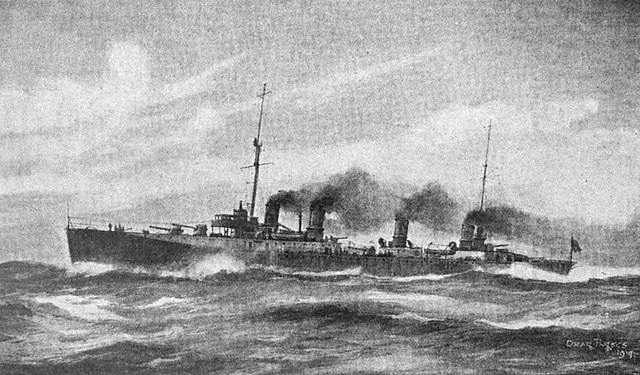
Illustration of the Marsala
Design of the Nino Bixio
Hull construction and specifics
The Nino Bixio class ships were designed as fleet scouts, under the supervision of Captain and engineer Giuseppe Rota. It was roughly similar dimilar to the Quarto, first Italian scout cruiser. The waterline length was 131.4 meters (431 ft) or 140.3 m (460 ft) overall. Their beam was of 13 m (43 ft) with a draft of 4.1 m (13 ft). They displaced 3,575 long tons (3,632 t), up to 4,141 long tons (4,207 t) at full load. Their silhouette was easy to identify with two pole masts with spotting tops far apart, the first aft of conning tower. The crew comprised 13 officers and 283 sailors.
Protection:
Protection was light, despite their classification as “protected cruisers”. Indeed they had a 38 mm (1.5 in) deck, plus 100 mm (3.9 in) walls for their conning tower.
Propulsion
The powerplant of the Bixio class comprised three Curtiss steam turbines connected each to a propeller. Fourteen mixed coal/oil Blechynden boilers provided steam. The exhausts were trunked into four raked funnels in specific positions, also very specific to this model: The first two funnels were closely spaced aft of the foremast, the other farther spaced and further aft. Total output was 22,500 shaft horsepower (16,800 kW), enough for a top speed of 29 knots (54 km/h; 33 mph).
This was on paper however. Indeed, neither ship ever came close to this requirement. The major problem identified was they were overweight. Nino Bixio with forced heat could generate 23,000 shp (17,000 kW), with a top speed of 26.82 knots (49.67 km/h; 30.86 mph). Marsala was slightly faster, reaching 27.66 kn (51.23 km/h; 31.83 mph) with he same output, but this was a far cry compared to what was expected of them. The Bixio class proved a massive disappointment for the admiralty, especially compared to the previous Quarto. Their range was range 1,400 nautical miles (2,600 km; 1,600 mi) on the basis of a cruising speed of 13 knots (24 km/h; 15 mph), which was rather short.
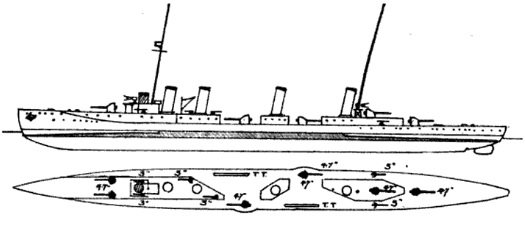
Marsala line drawing
Armament
Main armament: Six 120 mm (4.7 in) L/50 guns, on single mounts, shielded. The first pair was placed side by side forward, four more were placed on the centerline, two were places amidships and two placed in a superfiring pair, aft of the mainmast. These guns were of the same EE type pattern as those of Dante Alighieri and Conte di Cavour. They were made by Armstrong Whitworth.
Each gun weighted 3.35-metric-ton (3.30-long-ton; 3.69-short-ton) and fired a 22.5-kilogram (50 lb) shell at 860 meters per second (2,800 ft/s. The rate of fire on average was 6 shots per minute.
Secondary: Both cruisers completed this by having six 76 mm (3 in) L/50 guns of the the same Pattern ZZI also used by the the Italian dreadnoughts, intended for close range defence against torpedo boats. The guns weighed 1.14 t (1.12 long tons; 1.26 short tons) each. They fired 5.6 kg (12 lb)/7 kg (15 lb) shells at 815 m/s (2,670 ft/s). Rate of fire was 15 shells per minute.
Torpedoes: Both ships had two broadside submerged 450 mm (17.7 in) torpedo tubes.
Miles: Their decks were fitted with rails long enough to store and release 200 naval mines.
The Nino Bixio in action
Italian neutrality at the start of the war prevented any operations other than patrols, notably towards Austria-Hungary. In May 1915, the Triple Entente won the “contest” and Italy joined over promises of territorial spoils. The main Italian fleet was at first confined at the southern end of the Adriatic, at Brindisi, closing access to the Austro-Hungarians, and in the port of Taranto, safe from Austro-Hungarian U-boats. Indeed the latter mostly used small craft and U-boats and avoided large scale sweeps. Nino Bixio and Marsala were Brindisi, and prepared for any sortie of the Austro-Hungarian Navy. In December 1915, Nino Bixio teamed with British cruisers after an Austro-Hungarian attack on transports intended for the Serbian Army through Albania. Nino Bixio spotted and chased the scout cruisers SMS Helgoland and exchanged fire, whereas the latter, much faster, escaped under cover of darkness.
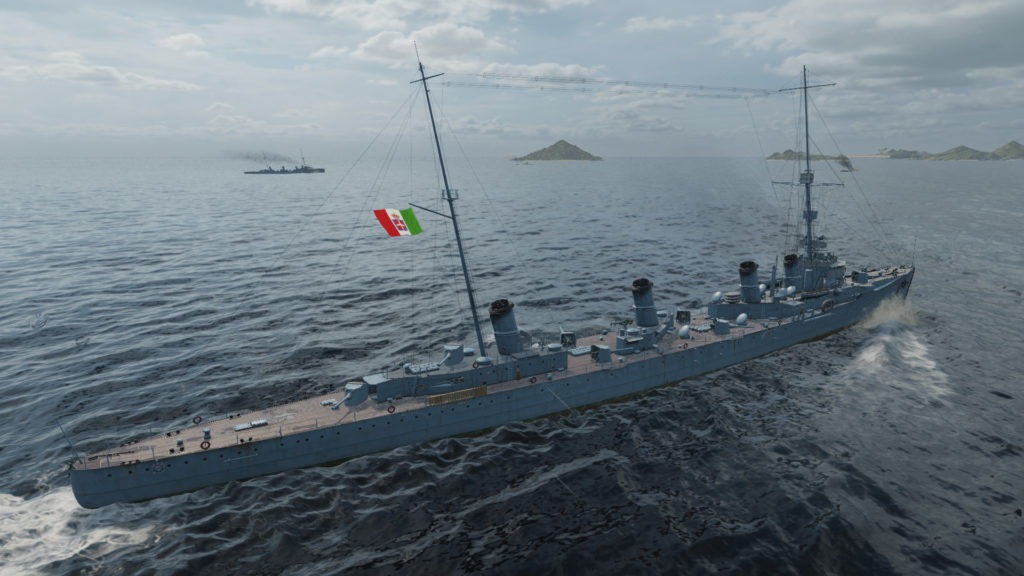
Marsala was present in the Battle of the Otranto Straits, by May 1917. Nino Bixio could not howevr built steam fast enoughj to be ready and missed the battle. Marsala duelled with the Austro-Hungarian cruisers, but Rear Admiral Alfredo Acton decided to broke off the engagement as the Austro-Hungarian armored cruiser SMS Sankt Georg was spotted on the horizon, in reinforcement.
These were the only occasion both ships exchanged fire, but funding cuts after the end of the war in 1918 up to 1921-22 meant the Regia Marina could not support the two Nino Bixio class. Choices had to be made. Despite they were among the most modern Italian cruisers, given the fact they never met design expectations, the choice was made quickly to delete them from the naval budget. Both cruisers were stricken from the register in March 1929 and November 1927 respectively. They were sold for scrap after a career of barely ten years.
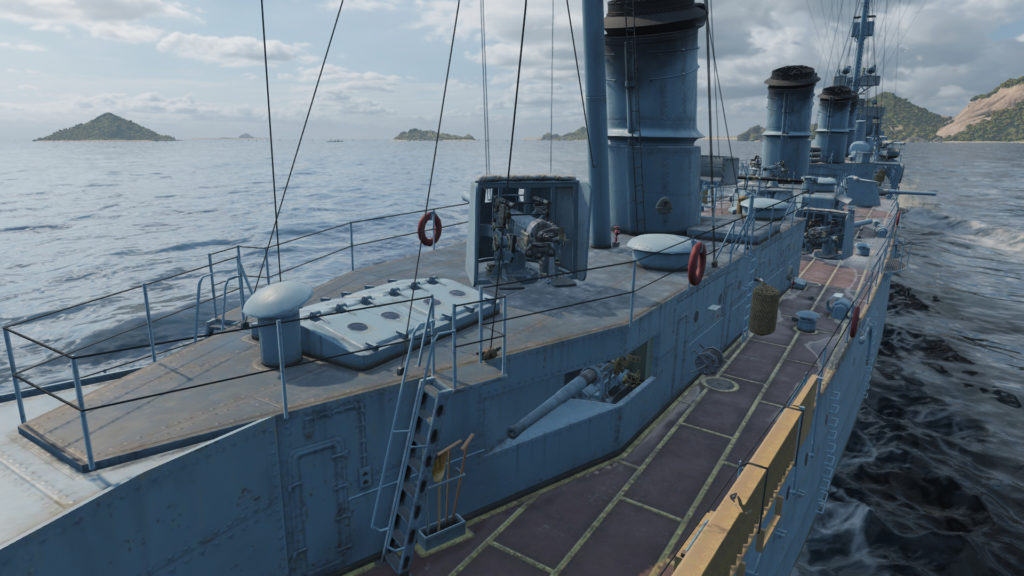
Nino Bixio
Nino Bixio, was named after a famous Italian soldier and politician, laid down at the Castellammare di Stabia shipyard. Nino Bixio’s keel was laid down on 15 February 1911, just as the Marsala. However she was launched ten months later (30 December). Fitting-out work ended by 5 May 1914, and she was commissioned into the Regia Marina. Admiral Paolo Thaon di Revel (naval chief of staff) believed Austro-Hungarian submarines would have a hard time to operate in the narrow waters of the Adriatic and through minefields. Still, their threat obliged him to setup a blockade at the southern end of the Adriatic instead with the main fleet. To avoid submarines, smaller vessels (notably the famous MAS boats) would sweep these waters and raid when possible Austro-Hungarian ships and installations. Nino Bixio and Marsala teamed logically with Quarto at Brindisi. On paper thy made the “quick reaction force” of the Royal Italian Navy, patrolling on the invisible border between the Adriatic to the Mediterranean.
By May 1917, Italian reconnaissance naval forces at Brindisi fell under ordered of Rear Admiral Alfredo Acton. The night of 14–15 May, Austro-Hungarian cruisers Helgoland, Novara, and Saida raided the Otranto Barrage. They rampaged into a line of drifters blocking the way out of the adriatic. However Bixio missed the Battle of the Otranto Straits, as her boilers failed to heat up in time to join the fray.
Severe budgetary shortfalls after the war draw attention to the most valuable ships to be maintained into service. Nino Bixio and Marsala had a sped problem throughout their service life and despite their limited service, it was decided to retire them. Bixio was stricken from the naval register on 15 March 1929, she was sold for scrap. The Italian admiralty however choose to keep the faster but older Quarto for another decade.
Marsala
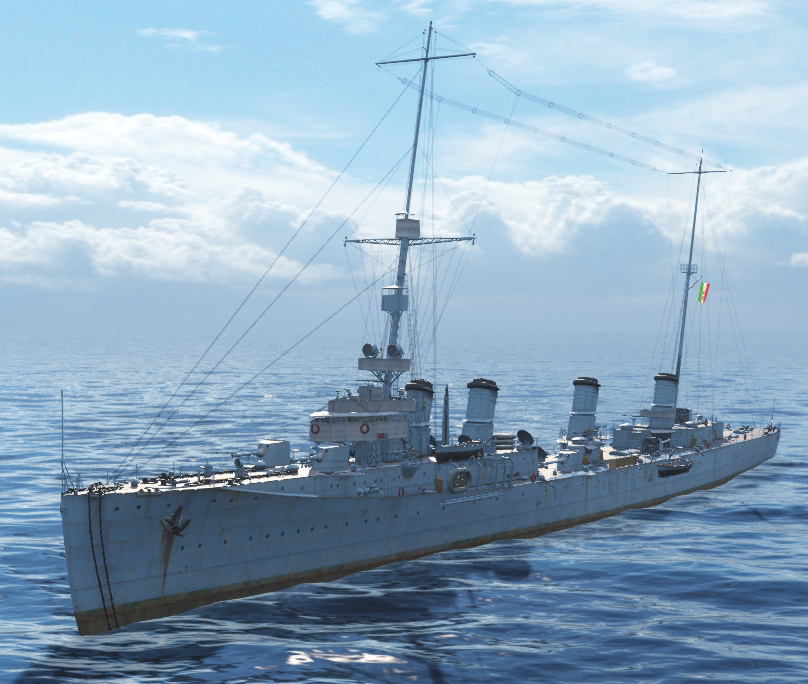
Marsala was laid down at the Castellammare di Dtabia shipyard on 15 February 1911 as Nino Bixio and she was launched on 24 March 1912, and christened after the city which saw Giuseppe Garibaldi launch his famous Thousand Expedition in 1860. After fitting-out Marsala was commissioned on 4 August 1914. She was based at Brindisi, like her sister ship Bixio and Quarto, called the “reconnaissance squadron”, intended to patrol the Adriatic-Mediterranean area.
In May 1917, this force was placed under Rear Admiral Alfredo Acton and during the night of 14–15 May, a raid took place with the SMS Helgoland, Novara, and Saida on the Otranto Barrage. One of the drifter was able to communicate the event and available forces were rushed into action. Marsala by then and by chance, managed steam up her boilers fast enough at the news of the attack and could depart, after the British cruisers HMS Dartmouth and Bristol plus five Italian destroyers. Marsala arrived in time to engage the fleeing Austro-Hungarians cruisers but Acton broke off the pursuit as reinforcements were feared. This was her only wartime action. She remained at Brindisi without taking part in other major actions.
By November 1918, the Regia Marina demobilized its naval forces and was constrained by budgets cuts to scrap many ships. The troublesome Marsala’s engines and overweight were seen not worth taing the time and money to improve them. This made an easy victim in the effort to trim the Regia Marina’s budget, stricken on 27 November 1927 and broken up later.
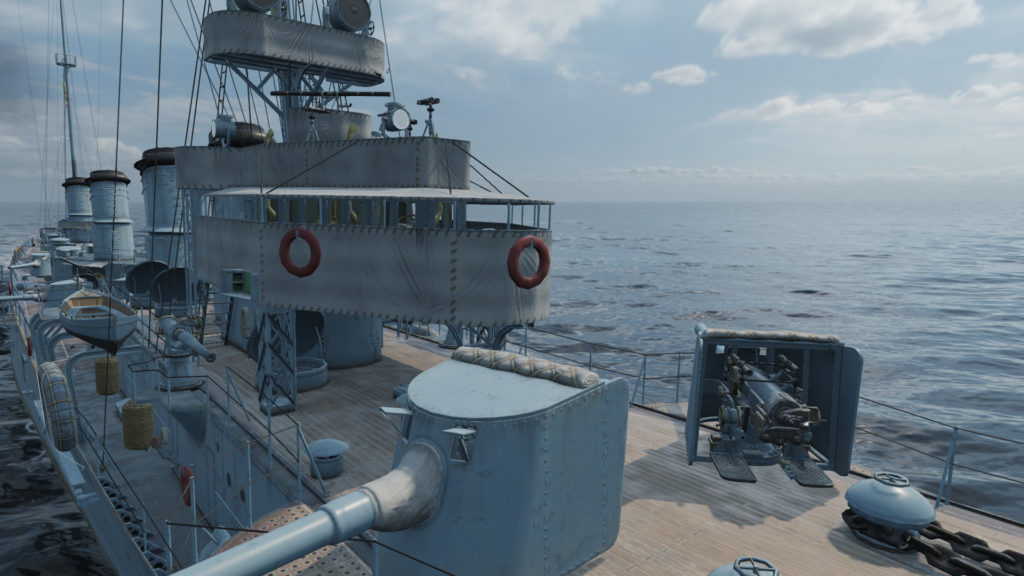
Bixio class in 1914 – author’s rendition.
Links/Src
Specs Conway’s all the world fighting ships 1906-1921.
//en.wikipedia.org/wiki/Nino_Bixio-class_cruiser
//www.worldnavalships.com/italian_cruisers.htm
//web.archive.org/web/20110104185951/http://www.marinai.it/contatti/bixio.pdf
//www.navypedia.org/ships/italy/it_cr_bixio.htm
On agenziabozzo.it (IT)
//www.gwpda.org/naval/fadri.htm
Bixio class specifications |
|
| Dimensions | Lenght 143.3 m (460 ft), Beam 13 m (43 in), Draft 4.1 m (13 ft) |
| Displacement | 3,575 long tons, 4,141 tons FL |
| Crew | 13 + 283 |
| Propulsion | 2 shaft steam turbines, 14 × Blechynden boilers, 23,000 shp (17,000 kW) |
| Speed | 26.82-27.66 kn (49.67/31.83 mph) |
| Range | 1,400 nmi (2,600 km; 1,600 mi) @ 13 kn (24 km/h; 15 mph) |
| Armament | 6× 120 mm (4.7 in), 6× 76 mm (3 in), 2× 450 mm (17.7 in) TTs, 200 mines . |
| Armor | Deck: 38 mm (1.5 in), Conning tower: 100 mm (3.9 in) |


 Latest Facebook Entry -
Latest Facebook Entry -  X(Tweeter) Naval Encyclopedia's deck archive
X(Tweeter) Naval Encyclopedia's deck archive Instagram (@navalencyc)
Instagram (@navalencyc)





 French Navy
French Navy Royal Navy
Royal Navy Russian Navy
Russian Navy Armada Espanola
Armada Espanola Austrian Navy
Austrian Navy K.u.K. Kriegsmarine
K.u.K. Kriegsmarine Dansk Marine
Dansk Marine Nautiko Hellenon
Nautiko Hellenon Koninklije Marine 1870
Koninklije Marine 1870 Marinha do Brasil
Marinha do Brasil Osmanlı Donanması
Osmanlı Donanması Marina Do Peru
Marina Do Peru Marinha do Portugal
Marinha do Portugal Regia Marina 1870
Regia Marina 1870 Nihhon Kaigun 1870
Nihhon Kaigun 1870 Preußische Marine 1870
Preußische Marine 1870 Russkiy Flot 1870
Russkiy Flot 1870 Svenska marinen
Svenska marinen Søværnet
Søværnet Union Navy
Union Navy Confederate Navy
Confederate Navy Armada de Argentina
Armada de Argentina Imperial Chinese Navy
Imperial Chinese Navy Marinha do Portugal
Marinha do Portugal Mexico
Mexico Kaiserliche Marine
Kaiserliche Marine 1898 US Navy
1898 US Navy Sovietskiy Flot
Sovietskiy Flot Royal Canadian Navy
Royal Canadian Navy Royal Australian Navy
Royal Australian Navy RNZN Fleet
RNZN Fleet Chinese Navy 1937
Chinese Navy 1937 Kriegsmarine
Kriegsmarine Chilean Navy
Chilean Navy Danish Navy
Danish Navy Finnish Navy
Finnish Navy Hellenic Navy
Hellenic Navy Polish Navy
Polish Navy Romanian Navy
Romanian Navy Turkish Navy
Turkish Navy Royal Yugoslav Navy
Royal Yugoslav Navy Royal Thai Navy
Royal Thai Navy Minor Navies
Minor Navies Albania
Albania Austria
Austria Belgium
Belgium Columbia
Columbia Costa Rica
Costa Rica Cuba
Cuba Czechoslovakia
Czechoslovakia Dominican Republic
Dominican Republic Haiti
Haiti Hungary
Hungary Honduras
Honduras Estonia
Estonia Iceland
Iceland Eire
Eire Equador
Equador Iran
Iran Iraq
Iraq Latvia
Latvia Liberia
Liberia Lithuania
Lithuania Mandchukuo
Mandchukuo Morocco
Morocco Nicaragua
Nicaragua Persia
Persia San Salvador
San Salvador Sarawak
Sarawak Uruguay
Uruguay Venezuela
Venezuela Zanzibar
Zanzibar Warsaw Pact Navies
Warsaw Pact Navies Bulgaria
Bulgaria Hungary
Hungary

 Bundesmarine
Bundesmarine Dutch Navy
Dutch Navy Hellenic Navy
Hellenic Navy Marina Militare
Marina Militare Yugoslav Navy
Yugoslav Navy Chinese Navy
Chinese Navy Indian Navy
Indian Navy Indonesian Navy
Indonesian Navy JMSDF
JMSDF North Korean Navy
North Korean Navy Pakistani Navy
Pakistani Navy Philippines Navy
Philippines Navy ROKN
ROKN Rep. of Singapore Navy
Rep. of Singapore Navy Taiwanese Navy
Taiwanese Navy IDF Navy
IDF Navy Saudi Navy
Saudi Navy Royal New Zealand Navy
Royal New Zealand Navy Egyptian Navy
Egyptian Navy South African Navy
South African Navy






























 Ukrainian Navy
Ukrainian Navy dbodesign
dbodesign